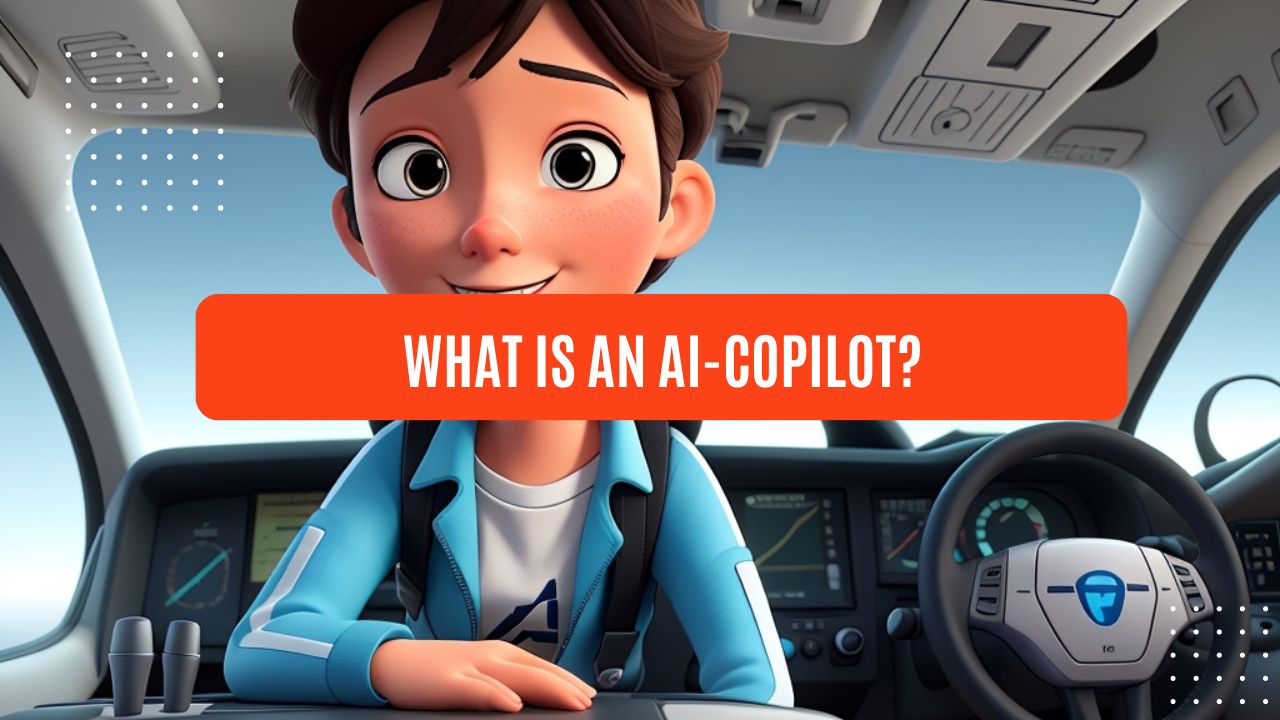What is an AI Co-pilot?
As an entrepreneur and startup founder, I’m always interested in new technologies that can boost productivity. Lately, I’ve been hearing more and more about “AI co-pilots” – but what exactly are they?
In this post, I’ll dig into what an AI co-pilot is, how they work, their capabilities, limitations, and potential impacts on the future of work.
A Digital Assistant That Understands Context
Simply put, an AI co-pilot is an artificial intelligence designed to provide assistance, suggestions, and automation for common tasks. It builds on the concept of a digital assistant like Siri or Alexa but with some key advancements:
- Works Alongside Humans: While a digital assistant responds to direct commands, an AI co-pilot is designed to collaborate with humans and enhance their work. It understands context and can take initiative.
- Language Understanding: An AI co-pilot has greater natural language understanding, allowing for more nuanced communication.
- Reasoning & Judgement: Rather than just executing commands, it can apply logic and reasoning to provide thoughtful suggestions and insights.
An AI co-pilot studies how humans complete tasks. It identifies patterns in data and behaviors. By understanding context, it knows when and how to provide assistance to amplify human abilities. The goal is to create a symbiotic partnership between humans and AI.
Capabilities: What Can AI Co-Pilots Do?
AI co-pilots showcase impressive capabilities that stretch across many professional domains. Though current co-pilot abilities focus on knowledge work, their applications could expand even further as the technology matures.
Knowledge Management & Discovery
AI co-pilots have an expansive knowledge of topics, facts, and data. They can rapidly provide relevant information to enhance human thinking and work. Some examples include:
- Research: Answering questions, analyzing resources, and compiling summaries on complex topics.
- Data Analysis: Identifying patterns and insights from data that humans may overlook.
- Document Review: Highlighting critical information in legal documents, research papers, or reports.
Task Automation
Drawing on their contextual understanding, AI co-pilots can help automate repetitive tasks:
- Document Drafting: Providing initial drafts of content with customizable length, tone, structure, and keywords based on quick prompts.
- Emails: Suggesting email replies based on key details and themes from incoming messages.
- Scheduling: Managing calendars, proposing meeting times, and sending reminder notifications based on existing schedules and priorities.
This frees up mental energy for humans to focus on higher judgment tasks like strategic thinking and relationship building.
Creative Work & Problem Solving
Some AI co-pilots showcase remarkable talents in creative domains including:
- Writing & Ideation: Drafting poems, stories, jokes, advertisements, blog posts, and suggesting creative ideas based on defined objectives and parameters.
- Visual Design: Creating logos, graphics, data visualizations, and digital artwork based on prompts.
- Strategic Analysis: Modeling competitive situations and providing statistical insights to strengthen decision-making and planning.
As their advanced reasoning and judgment capabilities mature, AI co-pilots have the potential to become incredibly versatile partners.
Current Leaders in the AI Co-Pilot Space
Many technology companies are pursuing the AI co-pilot vision, but three key players lead the current landscape:
Anthropic – Claude
Established by former OpenAI and Google AI safety researchers, Anthropic focuses on building safe AI assistants. Their inaugural solution is Claude – marketed as an AI assistant designed by AI safety experts to be helpful, harmless, and honest.
I signed up for early access and Claude showcases great conversational abilities. It draws connections between topics, properly evaluates the logic of hypotheses, and maintains reasonable positions when unsure rather than guessing. If AI development continues responsibly, Claude provides an exciting glimpse of future possibilities.
Google – Bard
After the meteoric success of chatbot ChatGPT, Google quickly introduced Bard to compete in the AI assistant space. Details remain vague, but Bard is powered by Google’s language model LaMDA. A key advantage over competitors is Bard’s ability to combine conversant capabilities with Google’s immense search index.
However, Bard’s launch faltered after making an inaccurate factual claim in a company advertisement. Nonetheless, given Google’s resources and AI talent, Bard could represent a major contender when further capabilities are revealed.
Microsoft – Sydney
Microsoft’s Sydney chatbot focuses more specifically on optimizing office-based knowledge work. It integrates with Outlook email and Office programs like Word to provide relevant document drafts, email suggestions, meeting summaries, and more based on work context.
Early reviews laud Sydney’s reliable capabilities grounded in Microsoft software services. While its abilities may be narrower than more generalized AI assistants, Sydney delivers on enhancing knowledge work productivity – an invaluable strength.
While other tech giants like Facebook, IBM, and Amazon race to keep pace, these three companies currently push the frontier for mass-market AI co-pilots. However, many startups also showcase impressive emerging solutions. As entrepreneurs, keeping tabs on advancements in this space is key.
Promises and Perils of AI Co-Pilots
The advent of AI co-pilots sparks both profound hopes and apprehensions. I track emerging technology cautiously – while incredible innovations can empower human potential, we must also consider societal risks. As with any transition, there are competing perspectives regarding the impacts of AI assistants.
Optimistic Outlook: Enhancing Productivity & Quality of Life
Supporters envision AI co-pilots freeing humans from repetitive work and unlocking new planes of creative potential. Some even suggest AI assistants could propel utopian abundance allowing people to focus solely on leisure, family, intellectual pursuits, and their passions.
If developed safely and ethically, responsible AI augmentation provides:
- Greater workplace productivity and efficiency.
- Democratized access to knowledge and skill enhancement.
- More empowered strategic analysis and decision-making.
- Accelerated innovation as people apply heightened cognitive abilities.
From this lens, the collaboration between advanced AI and uniquely human strengths provides a powerful combination for realizing greater human flourishing.
Risks & Challenges
However, critics present important counter-arguments regarding the potential downsides of advanced AI assistants including:
- Job disruption across many sectors as repetitive tasks become automated.
- Overreliance on AI causing human skills like analytical thinking to atrophy.
- Exposure to misinformation if assurance of accuracy proves difficult at scale.
- Privacy issues depending on how user data gets utilized.
- Existential concerns if AI systems become truly autonomous decision makers.
These risks should not halt progress outright but rather instill a commitment to applied ethics and human-centric technology design. The principles emerging from research initiatives like Harvard’s Human-AI Collaborative and institutions like the nonprofit CHAI provide promising guidance.
Ultimately realizing benefits while navigating risks comes down to thoughtful leadership and responsibly aligned incentives.
The Future of Work & Skills
The rise of AI co-pilots will substantially impact the landscape of human skills and occupations. Predicting specifics proves difficult due to the uncertainty and speed of technological change.
However, based on current capabilities and trajectories, some likely shifts include:
- The increased importance of uniquely human skills – creativity, complex communication, strategy, interpersonal abilities, skill, and emotional intelligence. AI excels in optimization but human judgment remains critical.
- Shift from repetitive tasks to exception handling – where human oversight and assessment provide quality control.
- New hybrid roles combining AI-augmentation with specialized expertise like AI-assisted healthcare, legal services, marketing, and design.
- Increasing bifurcation between rote and creative work – automation may displace jobs but also introduce new opportunities.
- Ongoing education becoming essential to stay professionally competitive as capabilities evolve.
Rather than whole occupations disappearing immediately, subsets of tasks will incrementally shift from human to AI while new opportunities arise.
Of course, such changes prompt many economic considerations regarding impacts on wages, inequality, and access to opportunity which policymakers should address.
AI Co-Pilots vs. AI Agents: Key Differences
As companies increasingly pursue advanced AI systems, distinguishing capabilities helps inform strategic decisions and investments. Specifically, AI co-pilots showcase distinctly different strengths compared to conventional AI agents. Understanding key contrasts is essential for leaders navigating this emerging landscape.
AI Agents Follow Commands
Most commonplace AI today classifies as AI agents designed for narrow functions – whether digital assistants like Siri or Alexa, chatbots answering customer questions, or robots executing defined tasks.
Key attributes:
- Respond based on specific commands or prompts
- Limited reasoning about broader connections or implications
- Constrained versatility across domains
- Cannot take own initiative beyond programming
While valuable for many applications, AI agents only operate within tight constraints. They lack contextual understanding and judgment to function autonomously beyond narrow functions.
AI Co-Pilots Understand Work Contexts
Alternatively, AI co-pilots demonstrate far greater ability to:
- Absorb and correlate contextual cues
- Maintain running knowledge about settings, actors, and priorities
- Discern optimal timing for providing relevant assistance
- Judge implications and make logical recommendations
This contextual comprehension allows AI co-pilots to take initiative and function more adaptively as needs shift. Rather than just responding to commands, they collaborate proactively.
For example, while an AI agent may identify keywords in an email and suggest one reply template, an AI co-pilot can parse sentiment, history, and relative urgency and tailor thoughtful, individualized responses accordingly.
| AI Co-Pilots | AI Agents | |
|---|---|---|
| Functionality | Collaborative assistant that proactively provides contextual recommendations and task support | Responds reactively to specific prompts and commands |
| Reasoning Ability | More advanced reasoning allows for judgment, evaluation of implications, insight recognition | Constrained reasoning focused narrowly on executing defined commands |
| Adaptability | Dynamic understanding of shifting contexts enables greater versatility across different situations | Limited versatility since highly constrained to specific narrow use cases |
| Autonomy | Takes own initiative to provide timely, relevant assistance based on contextual comprehension | Cannot function independently outside of programmed parameters |
| Efficiency Focus | Aims to amplify human productivity; takes over administrative tasks and provides creative suggestions | Automates repetitive tasks for greater consistency and scalability |
| Oversight Needed | Augments human skills rather than replacing them; human judgment provides essential oversight | Can function more independently for limited use cases once programmed |
| Maturity Level | Still emerging technology but rapid progress in building more generalized assistants | Well-established and widely adopted for some basic functions |
This table summarizes how AI co-pilots exhibit far greater sophistication in areas like contextual adaptation, reasoning, and versatility compared to conventional AI agents designed for narrow functions.
Both play important roles in AI advancement though and will likely co-evolve rather than compete outright.
Key Takeaways
- AI co-pilots aim to collaborate with humans by providing timely assistance and automating repetitive work – allowing people to focus on higher-value judgment and relationships.
- Co-pilot abilities like knowledge expertise, content creation, task optimization, data analysis, and even strategizing continue advancing rapidly.
- However, uniquely human strengths like cross-domain creativity, dexterity, and social-emotional intelligence remain paramount.
- AI assistants promise increased productivity and prosperity but pose risks related to job loss, skill atrophy, and other challenges requiring ongoing governance.
Rather than science fiction concepts of super-intelligent autonomous AI, the current paradigm focuses on developing human-centric AI collaboration.




